
Philipp Christoph Zeller was a German entomologist.

The Adelidae or fairy longhorn moths are a family of monotrysian moths in the lepidopteran infraorder Heteroneura. The family was first described by Charles Théophile Bruand d'Uzelle in 1851. Most species have at least partially metallic, patterned coloration and are diurnal, sometimes swarming around the tips of branches with an undulating flight. Others are crepuscular and have a drab coloration. Fairy longhorn moths have a wingspan of 4–28 millimeters, and males often have especially long antennae, 1–3 times as long as the forewing.
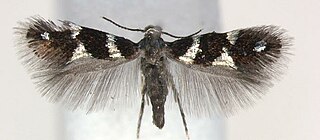
The Heliozelidae, commonly known as shield-bearer moths, are a family of small, day flying monotrysian moths distributed worldwide. The larvae of most heliozelid species are leaf miners who cut distinctive shield-shaped cases from the surface of the host leaf, hence the common name. Some species are considered pests of commercial crops such as grapevines, cranberries, and walnuts. The taxonomy of this family is poorly understood.

Argyresthia is a genus of moths in the family Argyresthiidae, previously treated as subfamily Argyresthiinae in the family Yponomeutidae. It is composed of over 200 species, over 100 of which are recognized across the Palearctic region. Species in the Neotropical realm have been less comprehensively described than other species.

The genus Crambus includes around 155 species of moths in the family Crambidae, distributed globally. The adult stages are called crambid snout moths, while the larvae of Crambus and the related genus Herpetogramma are the sod webworms, which can damage grasses.

Manulea is a genus of moths in the family Erebidae erected by Hans Daniel Johan Wallengren in 1863. The type species is Lithosia gilveola Ochsenheimer, 1810.
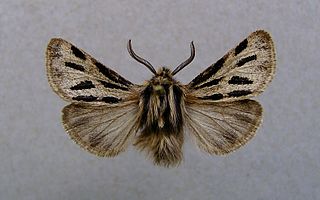
Ocnogyna is a genus of moths in the family Erebidae from western Eurasia. The genus was erected by Julius Lederer in 1853. One aberrant species, Ocnogyna parasita, has females with non-functional wings, and because of this was formerly placed in its own genus Somatrichia, but is now in Ocnogyna.
Pseudoblabes is a genus of moths in the subfamily Arctiinae first described by Philipp Christoph Zeller in 1853.

Ancylolomia is a genus of moths of the family Crambidae described by Jacob Hübner in 1825.

Ateliotum is a small genus of the fungus moth family, Tineidae. It belongs to the subfamily Myrmecozelinae.

Monopis is a genus of the fungus moth family, Tineidae. Therein, it belongs to the nominate subfamily, Tineinae.

Depressaria is a genus of moths in the superfamily Gelechioidea. It is the type genus of subfamily Depressariinae, which is often – particularly in older treatments – considered a distinct family Depressariidae or included in the Elachistidae, but actually seems to belong in the Oecophoridae.

Elachista is a genus of gelechioid moths described by Georg Friedrich Treitschke in 1833. It is the type genus of the grass-miner moth family (Elachistidae). This family is sometimes circumscribed very loosely, including for example the Agonoxenidae and Ethmiidae which seem to be quite distinct among the Gelechioidea, as well as other lineages which are widely held to be closer to Oecophora than to Elachista and are thus placed in the concealer moth family Oecophoridae here.
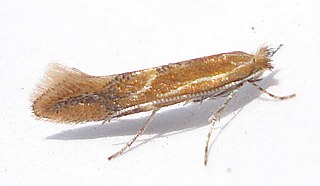
Phyllonorycter is a genus of moths in the family Gracillariidae.

Alucita is the largest genus of many-plumed moths ; it is also the type genus of its family and the disputed superfamily Alucitoidea. This genus occurs almost worldwide and contains about 180 species as of 2011; new species are still being described and discovered regularly. Formerly, many similar moths of superfamilies Alucitoidea, Copromorphoidea and Pterophoroidea were also placed in Alucita.
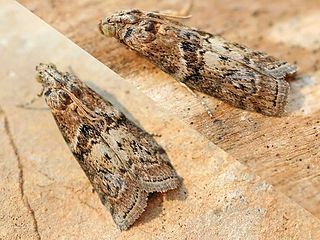
The Phycitinae are a subfamily of snout moths. Even though the Pyralidae subfamilies are all quite diverse, Phycitinae stand out even by standards of their family: with over 600 genera considered valid and more than 4000 species placed here at present, they unite up more than three-quarters of living snout moth diversity. Together with the closely related Epipaschiinae, they are apparently the most advanced lineage of snout moths.

Agonopterix is a moth genus of the superfamily Gelechioidea. It is placed in the family Depressariidae, which was often – particularly in older treatments – considered a subfamily of the Oecophoridae or included in the Elachistidae.

Mompha is a genus of moths in the family Momphidae that was first described by Jacob Hübner in 1819. It has four subgenera.
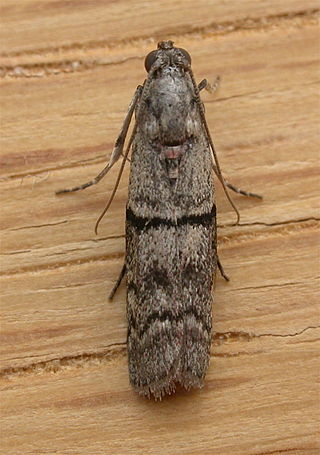
The Phycitini are a tribe of moths of the family Pyralidae.
Proutia is a genus of moths belonging to the family Psychidae.

















